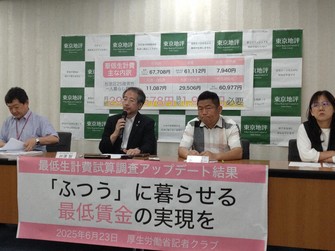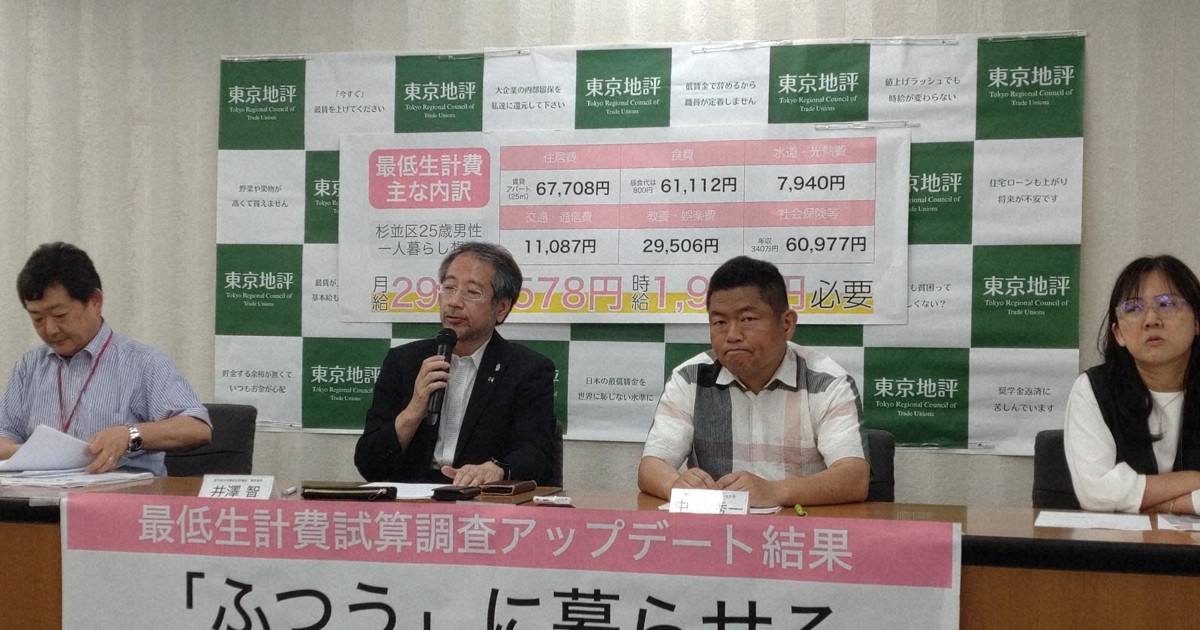
Shuichi Nakazawa of the University of Shizuoka Junior College, second from right, is seen with members of the Tokyo Regional Council of Trade Unions at the Ministry of Health, Labor and Welfare in Tokyo’s Chiyoda Ward on June 23, 2025. Nakazawa did the calculations for the union’s latest survey on minimum income required to cover living costs. (Mainichi/Satoshi Tokairin)
TOKYO — A single 25-year-old needs a minimum of just under 300,000 yen (about $2,030) to live a modest but ordinary life in the capital’s Setagaya Ward, according to a new study by the Tokyo Regional Council of Trade Unions (Tokyo Chihyo) — a sharp increase from the 2019 survey and well above the 2025 minimum wage for Tokyo.
The results show that a single 25-year-old man living in Setagaya Ward would need 296,560 yen per month and a woman 287,089 yen (about $2,007 and $1,943, respectively), both including taxes. To cover these costs, a man would need to earn at least 1,706 yen per hour and a woman 1,652 yen per hour, assuming 173.8 working hours per month and including taxes. Tokyo’s minimum wage set for 2025 is 1,163 yen per hour.
The study, supervised by associate professor Shuichi Nakazawa of the University of Shizuoka Junior College, updated a 2019 survey of workers’ living conditions and possessions. The latest figures reflect changes in prices, the impact of the COVID-19 pandemic, and new lifestyle trends. In May, researchers surveyed 191 workers and held a meeting to gather opinions from people in their 20s and 30s.
The study found that monthly food expenses rose sharply compared to 2019, with men spending 61,112 yen (up 16,751 yen) and women 48,019 yen (up 12,161 yen). The daily cost to cover 90% of required calories, including discretionary items, was 1,502 yen for men and 1,188 yen for women.
The results also reflected lifestyle changes. For example, young people reported spending more on digital subscriptions and home internet due to remote work and entertainment habits shaped by the pandemic. The monthly cost for culture and entertainment, including music and video streaming subscriptions (2,000 yen) and day trips (increased from 3,333 yen to 8,000 yen), rose to 29,506 yen total for men and 29,546 yen for women — about 4,000 yen more than in 2019.
Men’s monthly personal care expenses increased by about 500 yen to account for the growing use of cosmetics, previously only included for women. Wedding attendance costs were halved, reflecting fewer ceremonies, with men now budgeting 25,000 yen and women 35,000 yen per year. Year-end party expenses dropped from 1,250 yen to 1,000 yen per month for both genders, while annual spending on gifts for family and friends rose from 45,000 yen to 50,000 yen.
Housing costs were based on a 25-square-meter private rental in Setagaya Ward, a popular area among young people, with the lowest available rent set at 68,750 yen per month (up 3,125 yen from 2019, including prorated renewal fees).
Overall, the minimum monthly living cost (including taxes) increased by 37,089 yen for men and 30,898 yen for women compared to 2019.
Associate professor Nakazawa explained, “This is not a luxurious lifestyle, but it does include ordinary activities like enjoying entertainment or taking part in drinking parties. The gap between the minimum wage and the actual cost of living is striking. People earning the minimum wage or close to it must give up a normal life or work double or triple jobs just to get by.”
Nakazawa, who supervises minimum living cost studies in 27 prefectures, noted that while housing is expensive in major cities, the high car maintenance costs in regional cities mean overall living expenses are similar nationwide. With the spread of online shopping, this trend is only growing. “If living costs are nearly the same across Japan, the minimum wage should be standardized nationwide and set at a level that allows for a normal life,” he said.
The full report is available on the Tokyo Chihyo website at https://www.chihyo.jp/.
(Japanese original by Satoshi Tokairin, Tokyo City News Department)
